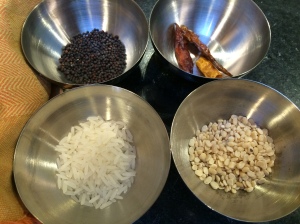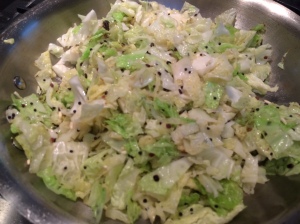Sometimes spice is just a state of mind. Plants don’t come with Dymo-printed labels that say ‘Spice use recommended’.
Now you might think I’m making an issue out of nothing. Obviously, plants that produce a strong appetizing smell can be used as spices, and others not, right? No mind tricks necessary.
But consider what happens during the process of blooming spices, otherwise known as tempering, or tadka. A sequence of spices are thrown into hot oil. They may be seeds — like cumin or black mustard, dry leaves like the bay, or even bits of bark — like cinnamon.
If the temperature is too low, nothing particular happens, while if the temperature is too high, the spice burns. But if the temperature is just right, two things happen. One, the outer surface of the spice browns. This browning, known as the Maillard reaction, is the perfect state of cooked food sought after by chefs, whether it is grill marks on meat or the browned crust of bread or cookies: Golden Brown and Delicious. Each spice produces its own browned flavor, which is reminiscent of its regular flavor, but sharpened and deepened.
The other thing that happens during blooming/tempering/tadka is that the oils inside the spice, those that carry the aromatic compounds, escape into the pool of oil in which they are cooking. As the oil slithers and smears all over the food, as it is wont to do, it carries the essential oils of the spice around with it too.
Tadka is such a powerful method that it has become a standard way to either begin or finish off most dishes in Indian cooking. But now, listen carefully, because this is the most important part. Once the key to unlock flavor known as tadka/tempering/blooming has been found, one can really excavate flavors from non-spices, from seeds that no one would particularly think of as a spice.
Don’t believe me? What would you say about split lentil beans used as spice? Well, in the south, two kinds of lentils, the urad dal and the channa dal are both used during tempering; they each create a characteristic roasty flavor.
Not impressed? How about rice? One of the unique things about the state of Kerala, which just happens to be the home of such stalwarts as pepper, ginger and cinnamon, is the use of raw rice as part of tempering, usually in coconut oil. Used in this way, bland old rice acquires a golden roasty flavor that permeates subtly throughout the food.
Thoran
i’m also having fun learning about one of Kerala’s signature dishes known as thoran. A simple and soothing preparation, it involves any vegetable cooked with some grated coconut, tempered simply with mustard seeds, curry leaves and possibly a couple other things. In my attempt, I left out the grated coconut, choosing instead to cook it in coconut oil to provide a similar sweetness.
This is the perfect kind of simple background where the use of raw rice in tempering can be shown off. So here we go — cabbage thoran.
Cabbage thoran
Ingredients:
- Half a head of cabbage, shredded
- 1 tablespoon coconut oil
- 1/2 teaspoon asafetida
- 2 teaspoons split and skinned urad dal
- 1 teaspoon black mustard seeds
- 2 teaspoons raw rice
- 5-7 curry leaves
- 3 small dry red chilies
- 3/4 teaspoon salt
- 1/4 teaspoon turmeric
- 1/4 teaspoon red chili powder (optional)
Method:
Heat the coconut oil in a wide, thick-bottomed pan on medium heat. When completely melted, add the spices in the following order: first, the asafetida; wait for it to foam up, then the urad dal; wait for it to start turning reddish, then, the mustard seeds; wait for them to start popping, then the raw rice; wait for it to all turn opaque and start to toast, then the dry red chilies; wait for them to darken, then the curry leaves.
Once the leaves crisp up, throw in the cabbage and stir to combine with the oil. Add the salt, turmeric and red chili powder and mix it nicely with the cabbage until it is evenly covered.
Cover the pan, turn the heat to a simmer and let it cook this way, in its own steam, for about 10 minutes more.
Serve with white rice, or, as I did, with chapati / roti and another side.
(Click here to find me on Facebook and here on Twitter.)











Kind of tangential but interesting that you are using coconut oil?
LikeLike
Hello lovely Annie. Yes, coconut oil. It has a unique fragrance when used in savory food, and instantly makes food taste South Indian.
LikeLike
Yummy! I just got some cabbage and it’s time to make Thoran 🙂
LikeLiked by 1 person
Thanks for a very thought-provoking post–in addition to the thoran recipe. I love cabbage (think it’s an under-appreciated vegetable) so I’m looking forward to trying this.
LikeLike
Simple, too.
LikeLike
Reblogged this on A single serving and commented:
Good information for all of us who cook using spices.
LikeLike
Love Kerela cuisine which I often have enjoyed at Maggie and Mathew (RIP) Mathews home on the backwaters of Aleepy. Haven’t had cabbage this way. I especially love the use of coconut in the many dishes as I first learned to cook Thai dishes in the mid 80’s. Been to Thailand and India 30 plus times each.
I was involved in the Coir Industry in Kerela. My late husband was with INFOSYS i.e. Bangalore co. I had office in New Friends Colony in New Dlhi. My agent became like sister, Anu Singh (wife of General JJ (Jogyi) Singh.
I miss those days of the Officer’s Club, birthdays at the Umaid Bahawan. Sigh must sturdy again.
LikeLike
I’m not native to Kerala either, but have spent some time each in Allepey and Cochin. I adored the food but there is so much more to explore.
LikeLiked by 1 person